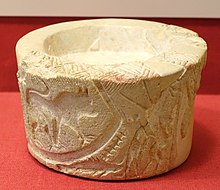A group
The A group is a prehistoric culture in sub- nubia whose origins are uncertain . It occurs from the first half of the 4th millennium BC. . BC until the beginning of the third millennium BC. BC and was widespread from southern Egypt (a little north of Aswan ) to the area of the 2nd Nile cataract .
The A group is a people with a semi-nomadic way of life who lived in loose family groups. There are hardly any social differentiations. Only in the later stages are there a few particularly richly furnished graves that are attributed to local chiefs. Sayala , Qustul and Dakka are considered the three largest settlement centers.
chronology
The A group is divided into three stages: the early, the classical and the late phase:
- The early A group existed at the same time as the Naqada I and early Naqada II phases in Upper Egypt; the sites range from Wadi Kubbaniya to Sayala.
- The classic A group occurs during the Naqada IId-IIIa phase with sites in Lower Nubia and south of the Second Cataract.
- The late A group coexisted with the Naqada IIIb phase, the 0th dynasty and the early 1st dynasty with sites in Lower Nubia and in the northern part of Upper Nubia.
economy

There were wheat , barley , and some fruits, such as date palms cultivated, in addition, there is evidence of livestock , such as goats and sheep. Cattle are rarely attested. The lack of large cattle may be due to the special climatic conditions of Lower Nubia. There was almost no sufficient grazing land here. Fish and wild catch can also be accepted. The pottery , leather processing and basketry were known, metal , however, not yet.
Trade contacts with Upper Egypt played an important role, from where grain, beer , wine and oil were imported in vessels. The high-quality objects produced, especially intended for the grave cult, include pallets , stone vessels, copper objects , pearls and amulets made of faience as well as shells from the Mediterranean . Special finds are a club with a gold handle and an incense burner from Qustul. It shows an unknown pharaoh with a white crown sitting on a boat and is considered to be the oldest representation of an Egyptian ruler to date.
Trade with Egypt increased significantly during the Naqada II period. Important trading centers were Elephantine and Seyala, where depictions of ships drawn on rock in the style of Naqada II were discovered.
Funerary cult
Group A graves are mainly simple oval pits and oval pits with a side chamber. Grave superstructures have not yet been proven. The buried person usually lies in a crouching position on the right side of the body with the head facing west. The eye-catching grave goods include sitting female figurines and imported luxury goods, e.g. B. Egyptian pearls.
Graves that were only very simply furnished or in which grave goods were completely missing were assigned to another culture by George Andrew Reisner , which he called the B group . According to today's view, these graves belonged to people of the A group with a lower social status.
Ceramics

The ceramic of the A group is done by hand, very fine and includes a number of different vessel types. Red-polished, black-rimmed ceramics with a black interior and partly corrugated surface were widespread; comparable ceramics also occurred in the Naqada culture in Upper Egypt. Painted geometric or linear patterns are characteristic of the A group. However, figurative painting, as it occurs at the same time in Egypt, was largely dispensed with.
Downfall
The A group is from around 2800 BC. BC in Lower Nubia can hardly be proven archaeologically . In the past, this has often been explained with the depopulation of Lower Nubia, which has been associated with the formation of the state in Egypt. The Egyptians would have depopulated Lower Nubia and deported the inhabitants to Egypt. However, according to recent studies, this thesis is not tenable; several Egyptian sources mention regular raids by the Egyptians to Lower Nubia, during which small cattle were captured, which suggests a continuous settlement. Therefore, it is now assumed that the bearers of the A-group culture temporarily returned to a purely nomadic way of life.
On the other hand, there is archaeological evidence that some people of the A group lived in the region around the city of Buhen at the time of the 4th and 5th dynasties . Furthermore, some sites between the Second and Third Nile Cataracts (between Batn el-Hajar and Kerma ) could be made out, which suggests a migration to Upper Nubia .
literature
- Rodolfo Fattovich: A-Group culture. In: Kathryn A. Bard (Ed.): Encyclopedia of the Archeology of Ancient Egypt. Routledge, London 1999, ISBN 0-415-18589-0 , pp. 79-80.
- Hans-Åke Nordström: Neolithic and A-group sites 2 volumes (= The Scandinavian joint expedition to Sudanese Nubia. Publications 3, 1-2). Läromedelsförlagen, Stockholm 1972, ISBN 91-24-21671-2 .
- Mathias Lange: The Nubian A group. In: Steffen Wenig, Karola Zibelius-Chen (ed.): The cultures of Nubia: an African legacy. Röll, Dettelbach 2013, ISBN 978-3-89754-397-3 , pp. 73-92.
Web links
Individual evidence
- ↑ a b c d e Rodolfo Fattovich: Encyclopedia of the Archeology of Ancient Egypt. London 1999, p. 79.
- ↑ a b Angelika Lohwasser : The prehistoric cultures of Lower Nubia . In: Gabriele Höber-Kamel (Hrsg.): Die predynastische Zeit (= Kemet Heft 4/2001), Kemet-Verlag, Berlin 2001, ISSN 0943-5972 , p. 30.
- ↑ a b c Rodolfo Fattovich: Encyclopedia of the Archeology of Ancient Egypt. London 1999, p. 80.
- ↑ Angelika Lohwasser: The prehistoric cultures of Lower Nubia . In: Gabriele Höber-Kamel (ed.): The predynastic time (= Kemet. Issue 4/2001). Kemet-Verlag, Berlin 2001, ISSN 0943-5972 , p. 29.